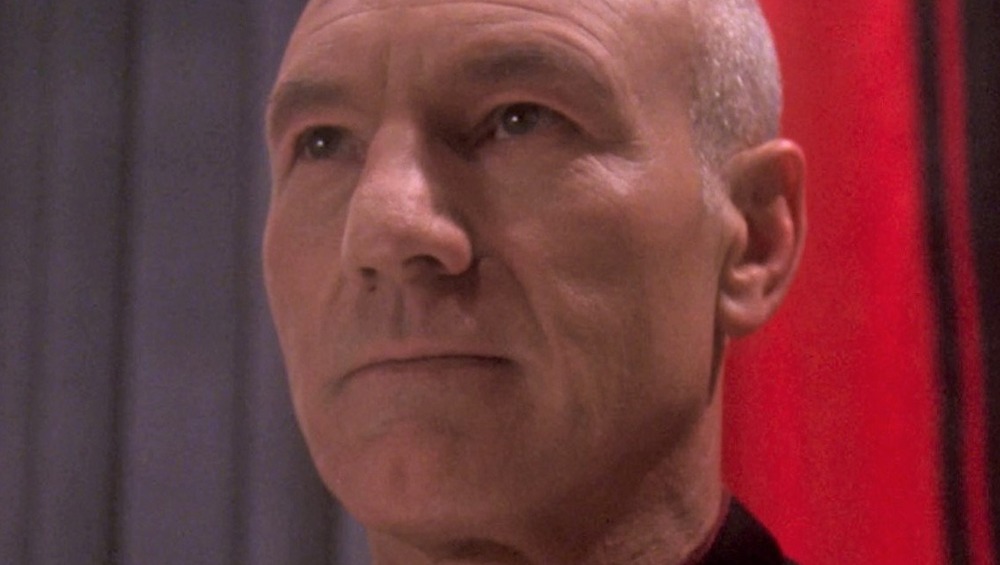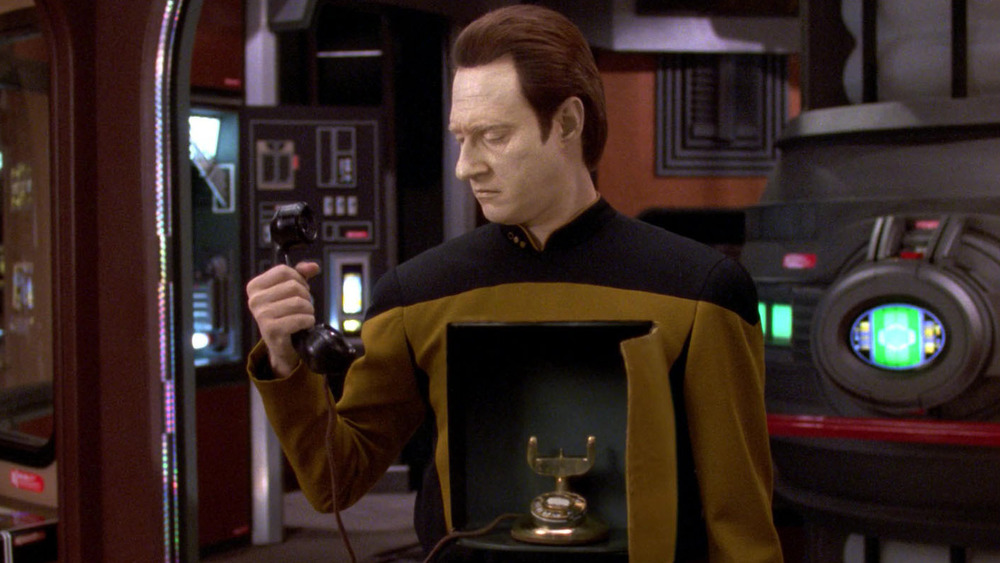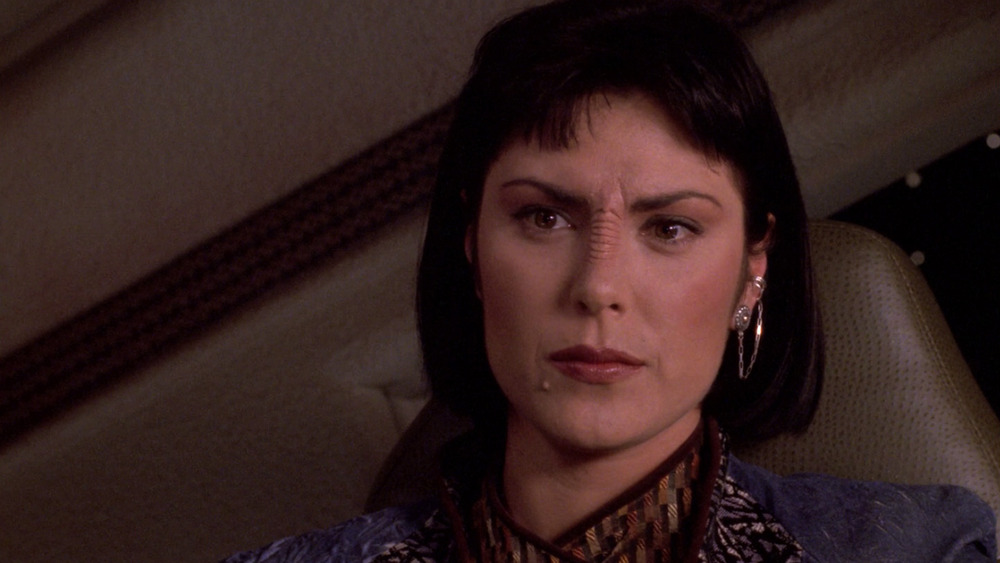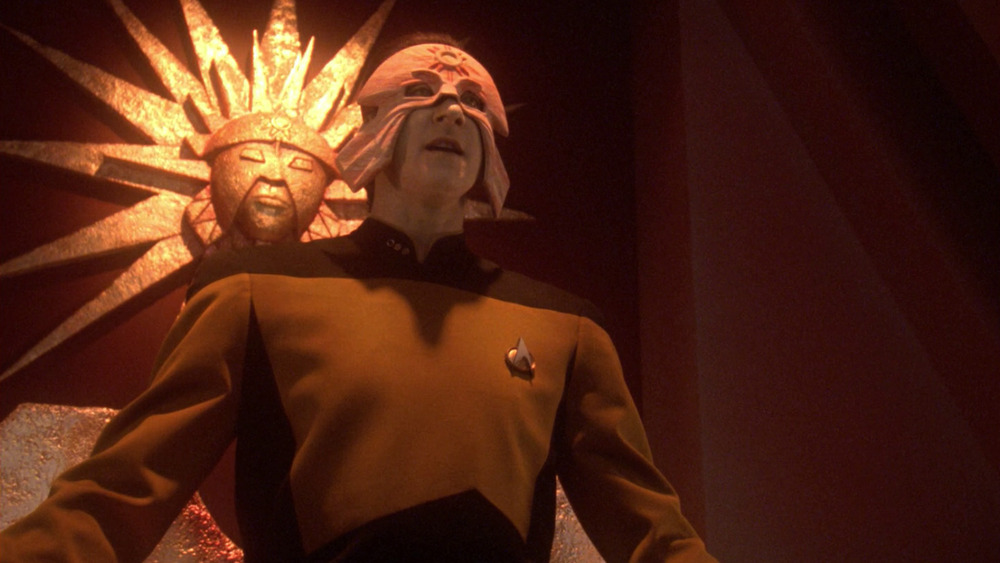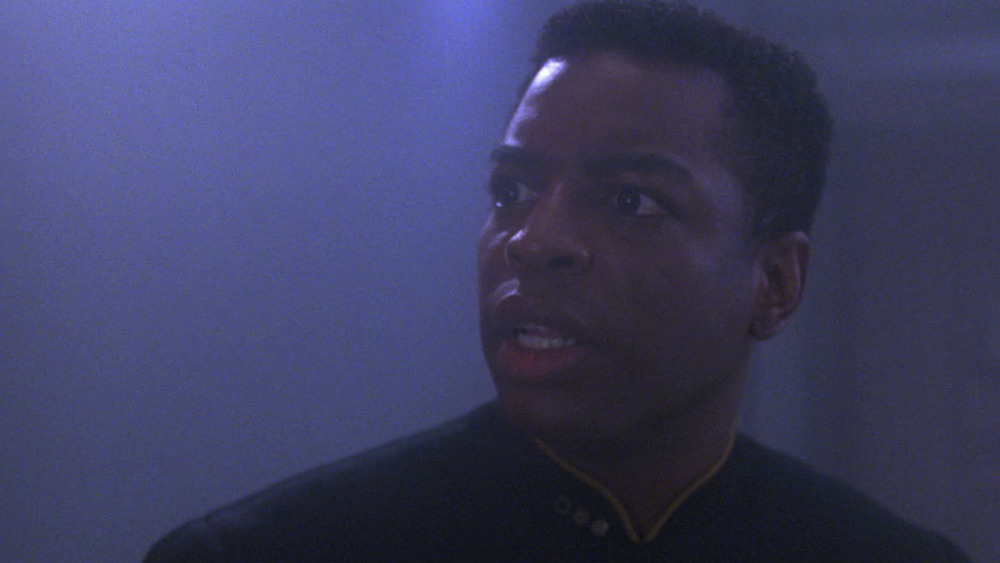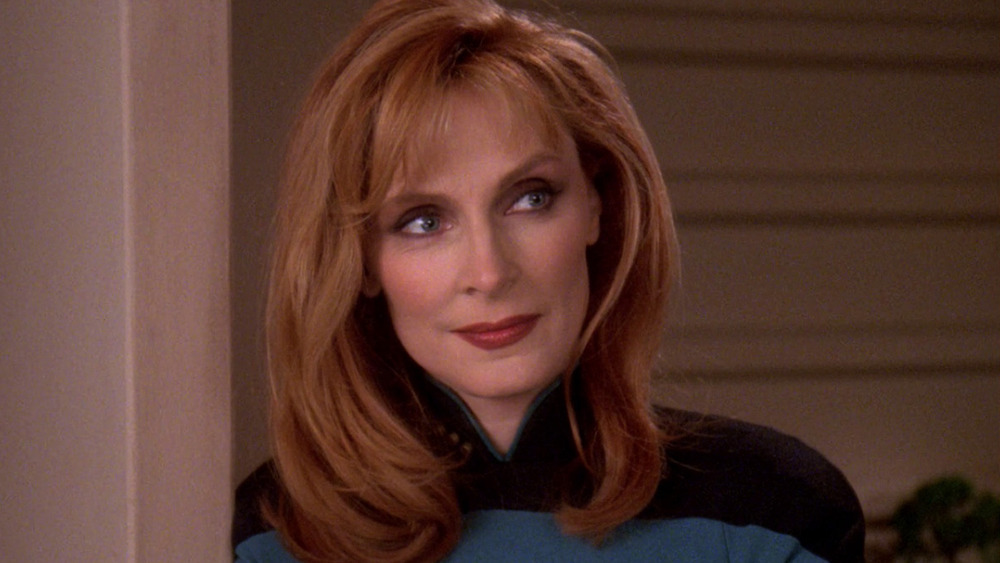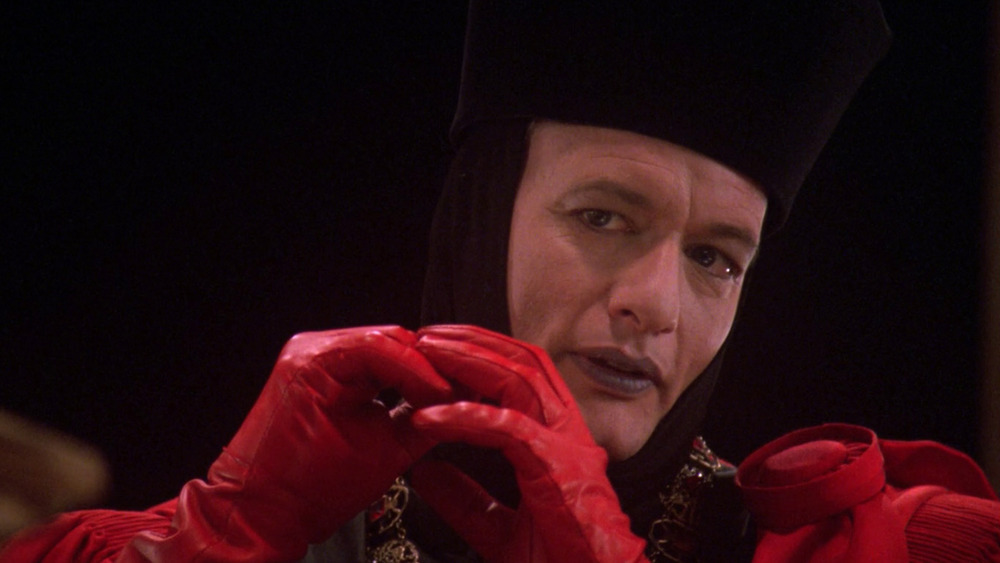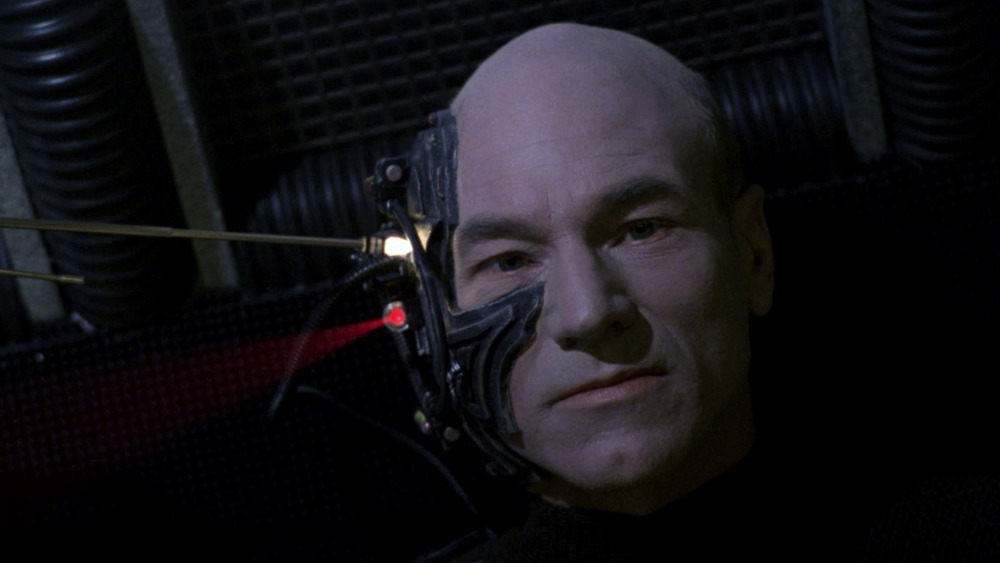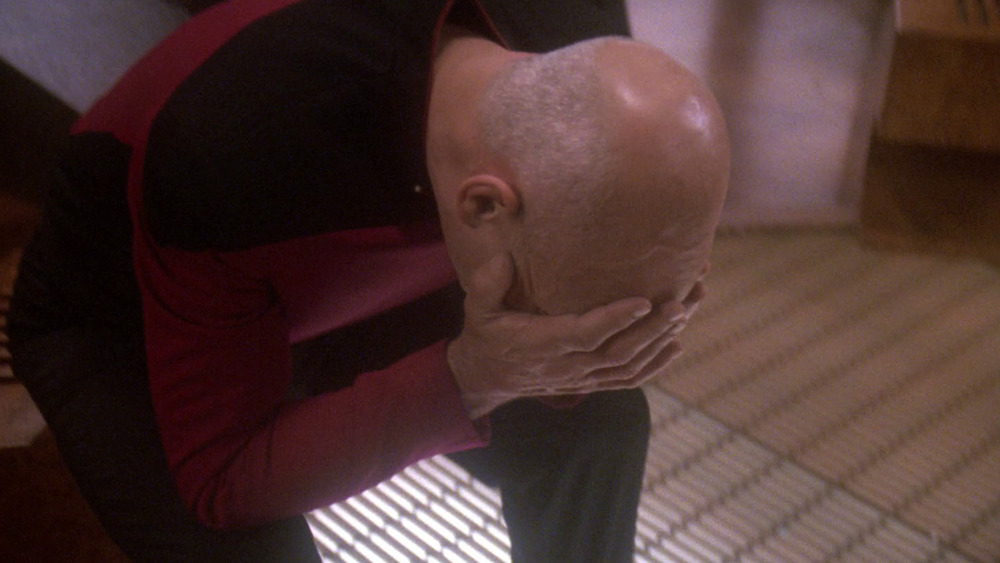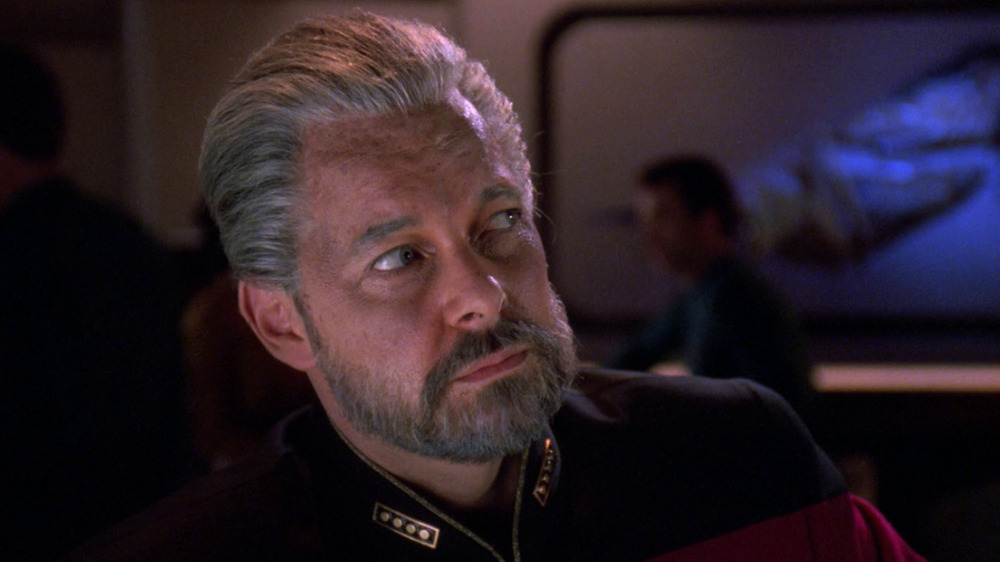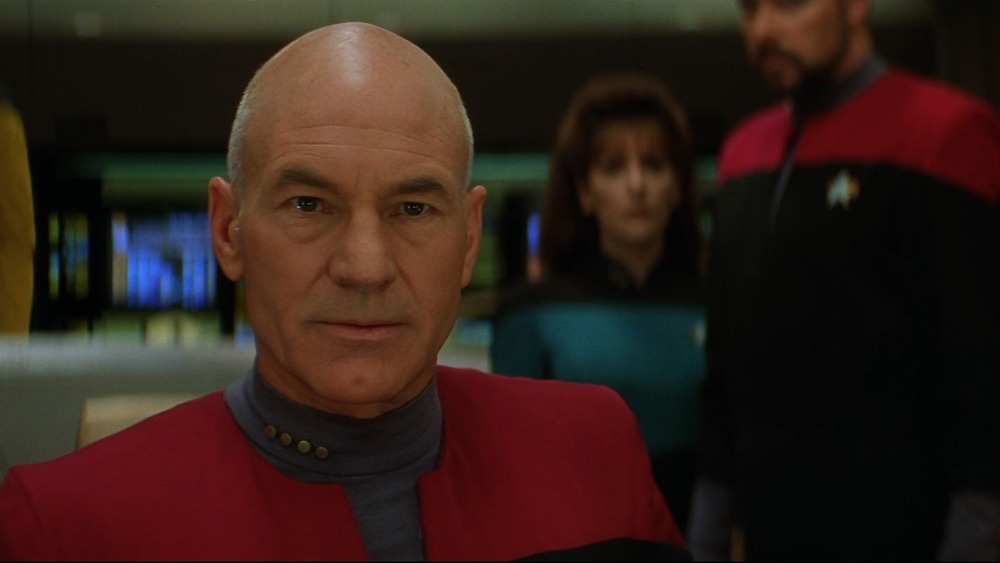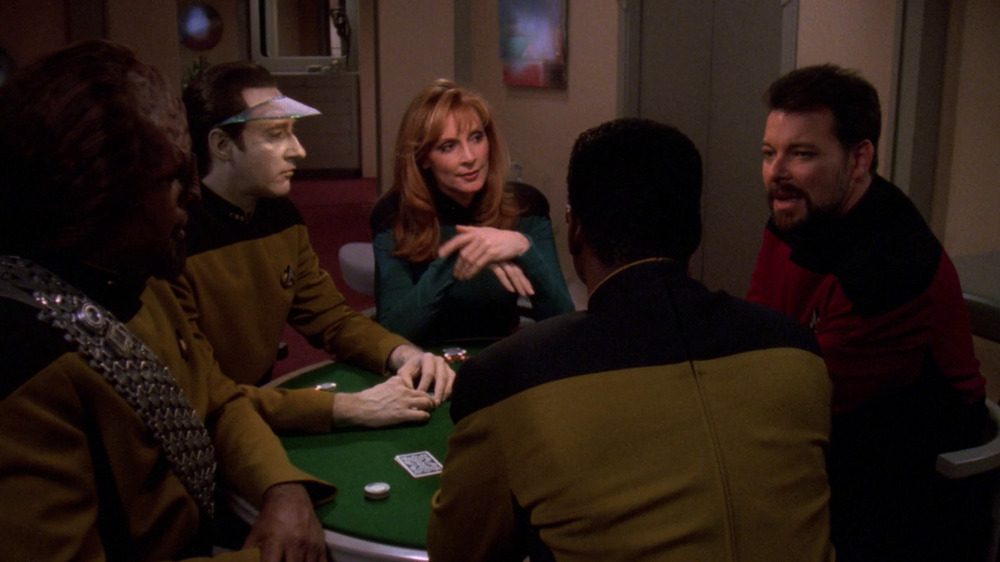What The Final Days On The Set Of Star Trek: The Next Generation Were Like
Star Trek has always had a passionate, cultish fanbase, but for a hot second in the mid-1990s, it was mainstream, must-see television. Star Trek: The Next Generation (TNG), the first live-action spinoff from the 1960s sci-fi series, debuted in 1987 and became a bona fide hit despite being syndicated (rather than on a network) and featuring none of the original Star Trek cast. It even spawned a spinoff of its own, Star Trek: Deep Space Nine (DS9), in 1993, meaning that Paramount Television was now producing about 50 episodes of Star Trek a year.
Audiences were surprised to learn that Paramount would be pulling the plug on their "mammoth hit" after its seventh season in 1994, but their grander strategy would soon become apparent. Star Trek was a hot property, and The Next Generation cast was popular enough that they seemed capable of carrying the baton for the Star Trek film series that had starred the Original Series cast, now six films deep. With Deep Space Nine picking up steam and an additional spinoff series, Star Trek: Voyager, on the way, The Next Generation left television in May 1994, only to return to movie theaters that same November with the feature film Star Trek: Generations.
The quick turnaround from television to film made the final days on the set of The Next Generation hectic and emotional, as the cast and crew felt the weight of the Star Trek franchise on their shoulders even after the series finale wrapped.
The writers' room was running on fumes
Star Trek: The Next Generation got to end on its own terms, with Paramount deciding during the fifth season to cap the series at seven years and then transition the cast immediately to the big screen. Still, the writers' room on TNG was struggling to keep the show fresh and interesting while also coping with the limitations of Star Trek's expanding universe. In the retrospective behind-the-scenes documentary The Sky's the Limit — The Eclipse of Star Trek: The Next Generation, writer/producer Ronald D. Moore expresses feeling "the oppressive weight of the continuity that [the writers] had created" towards the end of the series, which led to difficulty coming up with new storylines for the characters.
The writers' struggle for fresh stories led to a few great episodes, like "Lower Decks" — an episode focusing on junior officers instead of the regular cast — and "The Pegasus," an intense character drama delving into Riker's past, but on the whole, the storytellers' exhaustion was obvious throughout much of the final season. For example, over the course of its 26 episodes, there were four separate stories about a main character connecting with an estranged sibling or discovering a long-lost relative. There was also a growing reliance on "technobabble" in the show's scripts. In The Sky's the Limit, story editor and science consultant Naren Shankar describes his frustration with the storytellers beginning to care more about remaining consistent with the made-up science of the show than with real-life science.
The producers were planning the future of the Star Trek franchise
The seventh season of Star Trek: The Next Generation was created under a delicate set of conditions. Since writing and pre-production for the crew's first feature film, Star Trek: Generations, was already underway, season seven of TNG couldn't involve any major shake-ups in the status quo of the series. Instead, the writers focused on wrapping up smaller emotional arcs that wouldn't be addressed in the films, like the Picard/Crusher romance and the Riker/Troi/Worf love triangle.
TNG also needed to build some of the runway for the next spinoff, Star Trek: Voyager, which was in development at the same time. Voyager's own backstory relied on the existence of a rebellious Federation offshoot called the Maquis, who would be involved in a conflict with the Cardassians in a disputed area of space. TNG set up the conditions for the conflict in "Journey's End," in which the Federation/Cardassian border is redrawn to leave some Federation citizens on the other side.
Star Trek: Deep Space Nine, running concurrently, showed the explosion of the border conflict, giving birth to the Maquis faction. Finally, with its penultimate episode "Preemptive Strike," TNG built sympathy for the Maquis by placing one of the show's popular recurring characters, Ro Laren, among their ranks. In the retrospective documentary The Sky's the Limit, Trek author and archivist Larry Nemecek confirms that this was a deliberate effort to seed interest in the Maquis characters that would debut on Voyager.
The Next Generation stars were exhausted
By the start of the final season of The Next Generation, most of the principal cast had been inhabiting their roles for six full years, working rigorous schedules for 26 episodes a year (excepting the abbreviated second season). While the TNG cast is noted for having maintained a positive attitude and a strong feeling of family throughout and even after the series, fatigue was definitely beginning to set in, particularly for the actors portraying the show's most popular characters — Sir Patrick Stewart (Captain Jean-Luc Picard) and Brent Spiner (Lt. Commander Data).
In the documentary The Sky's the Limit — The Eclipse of Star Trek: The Next Generation, Stewart comments on the strain of the series' long run. "When we got into the seventh season ... some of that was a struggle, to stay focused and to keep doing the same level of work that we had all committed ourselves to."
Sometimes the production schedule would give a particular actor insufficient time to prepare for a coming episode. For instance, season seven featured two Data-centric episodes in a row — first "Thine Own Self" and then "Masks" immediately after, in which Brent Spiner plays five different characters. In The Sky's the Limit, Spiner blames the poor reception to "Masks" on his lack of time to make strong character decisions, calling some of his own acting choices "preposterous." It's no surprise that, when interviewed on the set of the finale by Entertainment Weekly, Spiner expressed total indifference to the end of TNG.
Some of the TNG cast weren't ready to let go
While Patrick Stewart and Brent Spiner both seemed ready for The Next Generation to come to a close, the same couldn't be said for the entire ensemble. After all, TNG was a hit show, and its cancellation near the peak of its popularity threw some of the cast for a loop.
"We're a family in crisis," said LeVar Burton in a 1994 Entertainment Weekly interview, regarding the emotional stress of the series coming to a close. Marina Sirtis — demonstrating the bluntness that fans would later come to enjoy at conventions — told EW, "People are subconsciously being pissy on the set so that it won't hurt so much when the show is finally over." Years later, in the retrospective The Sky's the Limit — The Eclipse of Star Trek: The Next Generation, Sirtis added that the series finale barely registered for her since she began filming Star Trek: Generations days later but that the reality of her time aboard the Enterprise coming to an end would hit her hard as soon as the movie wrapped.
"I haven't been given any reason that holds water," said Jonathan Frakes of the cancellation in that same EW feature. At the time, Frakes didn't see the urgency to transitioning the cast to the big screen, but he did end up benefiting from it, as he was hired to direct two of the four Next Generation feature films, First Contact and Insurrection.
Actors were working more behind the camera
The cast of The Next Generation may have had mixed feelings about their long tenures performing their characters, but they also relished the opportunity to learn new skills on set and try their hand at directing television. Ever since Jonathan Frakes took a swing at helming an episode of The Next Generation in season three (to great success), more and more of the regular cast asked to shadow directors so that they could learn the craft and take a crack at it themselves. By season seven, cast members made up nearly a quarter of the director rotation for the series.
Jonathan Frakes directed two episodes of the final season, "Attached" and "Sub Rosa," and would continue to have a long directing career on television for decades to follow. Patrick Stewart, who began directing in TNG's fourth season, also helmed two episodes of season seven, while LeVar Burton, who had his directorial debut the year before, took a second turn behind the camera for "The Pegasus." He's also continued to direct for television into the 2020s.
Gates McFadden was excited to finally get her first opportunity to direct with the episode "Genesis," an effort that (while the quality of the story itself may be lacking) roundly impressed the production crew, according to the documentary The Sky's the Limit. For McFadden, this would be her only screen credit as a director, though she remained a creative force in the theatre world.
The Next Generation finale was written in a hurry
Executive producers Rick Berman and Jeri Taylor invited the veteran Star Trek writing team of Ronald D. Moore and Brannon Braga — who'd spent the past year working on the screenplay for Star Trek: Generations — to pen the series finale. Unlike with Generations, however, Moore and Braga would have very little time to come up with the story and write the double-sized script. According to Jeri Taylor in The Fifty-Year Mission: The Complete, Uncensored, Unauthorized Oral History of Star Trek, Moore and Braga didn't get to start writing the actual script until nine days before production prep began for the episode, an intimidating lead time even by the standards of weekly television.
Working against the clock, the writing team found the seeds for the finale ("All Good Things...") in story ideas that they'd each had earlier in the season. According to the documentary The Sky's the Limit, Moore was keen on bringing back the extra-dimensional troublemaker Q, who also appeared in the series premiere, as a way to bookend the show. And Braga had an unused idea for a story in which Worf's son, Alexander, would bounce between the present and the future trying to solve a mystery. The pair combined their ideas into a story in which Captain Picard would be the one moving between time periods, not just to the future but to the beginning of the series as well, with Q as both antagonist and guide.
The script was heavily rewritten at the eleventh hour
Ronald D. Moore and Brannon Braga's first swing at writing the script for the TNG finale, "All Good Things...," was an even more complicated story than the version that aired on television. Instead of moving back and forth between the present day of the show, seven years in its past, and 25 years in its future, Captain Picard would also find himself in a fourth time period, that of the pivotal two-part episode "The Best of Both Worlds," in which Picard is kidnapped and assimilated by the Borg. Executive producer Michael Piller felt that this storyline muddled the natural "beginning, middle, and end" structure of the story, and he asked for it to be removed.
But even as the story began to take a more natural shape with only three time periods, Piller became concerned that the second half of the episode was meandering and plotless, and with only days before shooting was scheduled to begin, he ordered a drastic rewrite to add more plot. The changes were not universally popular. Both Patrick Stewart and Brent Spiner are on record as having complained about the new script, which they felt stripped away important character moments in favor of meaningless "technobabble." According to The Star Trek: The Next Generation Companion, many of these emotional beats found their way back into the script thanks to an additional rewrite meeting called by Patrick Stewart himself.
Story changes led to a stressful production
Due to the script coming in at the last minute and then being revised in the midst of preproduction, shooting "All Good Things..." was an even more tense affair than usual. In The Fifty-Year Mission: The Complete, Uncensored, Unauthorized Oral History of Star Trek, director Winrich Kolbe describes the panic created by the rewrites, saying, "I think, out of the 14 days of preparation I had, I sat around for nine days, and the last five days were just a frantic struggle to get it all together."
In The Star Trek: The Next Generation Companion, Kolbe also blames some of the additional stress on how distracted the cast and crew were at the time. The cast was engaged in contract negotiations for the film, which they would begin shooting almost immediately after "All Good Things..." wrapped, as well as hunting for their next steady paycheck. Shooting had to be scheduled around Gates McFadden filming a pilot in Oregon, which led to an additional day of shooting being added. The presence of a documentary crew creating a behind-the-scenes special and a visit from Entertainment Tonight didn't help matters, leading Patrick Stewart to lose his temper at an ET camera operator. Kolbe does credit the crew, however, with working through the exhaustion and distractions and coming together in the end to deliver a solid episode.
Creating the Next Generation finale was challenging on every level
Appropriately, the two-part finale of Star Trek: The Next Generation called for special attention from the set, costume, makeup, and visual effects departments. Traveling back in time seven years meant redressing some of the Enterprise sets to resemble how they looked in the series premiere, such as retrieving the original reclining chairs and restoring the old wooden wall panels on the bridge. Traveling forward 25 years into the future also required further changes to try and make the ship seem more futuristic, such as finally installing real, working television screens to the aft bridge consoles, as seen in the DVD featurette "The Making of 'All Good Things...'"
Michael Westmore's makeup team faced the challenge of aging up the cast for the future section. In "The Making of 'All Good Things...,'" Westmore explains that adding 25 years to the actors' faces was actually more difficult than making them "ancient," as it required more subtlety. A new "future" Starfleet uniform was also designed, which continued to be used in Star Trek stories set in this time frame on Deep Space Nine and Voyager.
"All Good Things..." was a special effects-heavy episode that involved multiple new or refitted starship models, as well as one very complex combination matte painting and optical effects shot. According to "The Making of 'All Good Things...,'" the scene in which Q takes Picard to Earth 3.5 billion years in the past took a combined 300 hours of effort to create.
Behind the scenes, the finale wasn't the end
When shooting wrapped on "All Good Things...," it was the end of production for The Next Generation, but for much of the cast and crew, their job on Star Trek simply continued on a new set or in a new role. The TNG cast moved directly to shooting Star Trek: Generations, with Marina Sirtis getting only three days off in between, according to The Sky's the Limit. (For other cast members, the break may have been shorter.) In addition to their four theatrical films, nearly every member of the regular TNG cast would return to appear Star Trek television in various spin-offs including Picard and Deep Space Nine.
Much of the writers' room and production crew transitioned onto either Deep Space Nine or Voyager. Showrunner Jeri Taylor co-created and produced Voyager, bringing Brannon Braga along with her, while Ronald D. Moore would join the writing staff of DS9. "All Good Things..." director Winrich Kolbe would work regularly on Deep Space Nine and Voyager for years to come, and TNG director of photography Jonathan West would shoot DS9 for the remainder of its seven-year run. Executive producer Rick Berman continued to oversee Star Trek films and television shows until 2005, when the franchise's 18-year continuous run on television finally came to an end.
The Star Trek crew's hard work paid off
While the tension on the set of The Next Generation's final episode was high, it's hard to argue with the results. "All Good Things..." not only drew the series' highest ratings ever, but it became an instant and enduring fan favorite that's been hailed by critics for decades as one of the greatest finales in television history. The episode won the 1995 Hugo Award for Best Dramatic Presentation, the last Star Trek work to date to bring home the vaunted sci-fi prize.
Plus, the final season of Star Trek: The Next Generation garnered ten Emmy nominations, including Outstanding Drama Series. TNG lost this award to Picket Fences, but as writer/producer Brannon Braga put it in The Sky's the Limit, "No offense to [Picket Fences creator] David Kelley, but I don't think you can watch Picket Fences on at any time of day in every country in the world."
Awards and critical acclaim are one thing, but if you really want to measure the success of "All Good Things...," just look any Trekkie in the eye and recount the episode's final line, "Five card stud, nothing wild, and the sky's the limit." Then watch the otherwise innocuous phrase bring them to tears.
